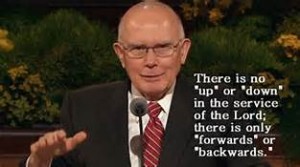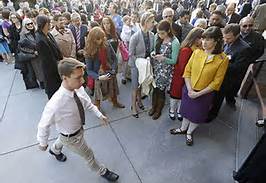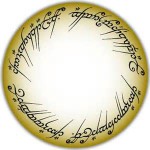I.
Elder Dallin H. Oaks gave a talk at the opening of the April 2014 General Conference Priesthood session titled The Keys and Authority of the Priesthood. I listened to it in real time knowing that, even as Elder Oaks was pronouncing his justification for women not being allowed to hold the priesthood, women were being denied entrance to the building in which he was speaking.
The question crossed my mind as to whether an apostle of Jesus Christ should be seeking to justify the exclusion of women in a meeting to which women were excluded, or to be outside the sealed building with those being excluded; not necessarily agreeing with them, but at least mourning with those that mourn and comforting those that stand in need of comfort.
I had decided my next blog would be an open letter to Elder Oaks, explaining why I disagreed with much of what he had to say in this address. But early drafts had a snarky tone I did not like.
II.
On the morning of Sunday, May 25th, 2014, my idea of an open letter to Elder Oaks went by the wayside as I was going to the closet to pick out clothes to wear to church.  My wife was reclining on the bed reading something intently on her I-Pad. “Do you know what is going to happen in church today?” she asked. I did not.
My wife was reclining on the bed reading something intently on her I-Pad. “Do you know what is going to happen in church today?” she asked. I did not.
“They are going to be teaching on Elder Oaks’ priesthood talk throughout the church today,” she continued, “The one on why women can’t have the priesthood. Ordain Women is encouraging people to wear purple to church in protest.”
“Really?” I said, immediately changing my mind as to what I was going to wear. I had on a light blue shirt by this time, and ditched it for something in more of a purple vein. I tried on a striped lavender pastel shirt with a matching tie and checked it out in the mirror. Not enough, I decided. If I was going to make a statement, I might as well go whole hog. I dived back into the closet for a deep purple shirt and grabbed a purple Jerry Garcia tie to go with it. If I had a purple suit, I would have worn that, too.
My wife put on a beautiful purple dress and purple shawl, accented with purple pendant and purple earrings. We got in the car with our 17-year old daughter and headed to church, not knowing what would happen, but definitely dressed for the occasion.
III.
Nothing was said about Elder Oaks’ talk in sacrament meeting, and Sunday school followed the  correlated Old Testament lesson. I was beginning to think maybe we had gotten bad Intel. The third hour was when the hammer fell.
correlated Old Testament lesson. I was beginning to think maybe we had gotten bad Intel. The third hour was when the hammer fell.
There would be a combined high priest/elders meeting in the chapel on the talk, while the same subject would be presented to the women separately in Relief Society. (I guess it would be counter-intuitive to have the women meet with the men when this talk was discussed.) Copies of the talk were distributed prior to the lesson. A kindly retired high priest (and former bishop) I have known for many years would be the instructor.
The instructor introduced the lesson and asked if Elder Oaks had not been a lawyer. I volunteered that Elder Oaks was a former justice of the Utah Supreme Court, which meant that he most definitely was a lawyer, and that this fact also explained why he was so boring. This remark was greeted by a surprising amount of laughter, perhaps because it found so much agreement, and perhaps because I was simultaneously making fun of myself, a practicing lawyer of 24-years.
The instructor laughed good-naturedly but said he found Elder Oaks’ talk very interesting. He proceeded with the lesson.
The instructor had somebody read the first section of Elder Oaks’ talk, about how “There is no ‘up or down’ in the service of the Lord,” and how the calling of Stake President is “equally honorable”  with that of ward nursery leader. The instructor asked if that was how things really were in the church, and called on me, likely because he saw me shaking my head disbelievingly in the back row.
with that of ward nursery leader. The instructor asked if that was how things really were in the church, and called on me, likely because he saw me shaking my head disbelievingly in the back row.
I said, “Well, maybe Elder Oaks sees things differently than I do, but from my 35-years in the Church, it seems to me to be very structured and hierarchical. A bishop is over a ward; a stake president is over a number of wards; an area president is over a number of stakes and the apostles are over everything. That seems pretty up-and-down to me.”
No one took issue with my somewhat obvious observation, and comments were made on the tangential subject of how we do not covet leadership callings in the Church. The instructor said that maybe going from Sunday school teacher to Priest Advisor might be an example of a “lateral move.” All agreed. Including me.
IV.
The instructor said the reason Elder Oaks had given this talk is because there is a “group of women” in the Church who are lobbying to get access to the Priesthood Session of General Conference; that he is not sure if that is all they want; but that Priesthood Session had been broadcast live the last two conferences so that they would know “we aren’t talking about anything secret.” Some class members chuckled at this idea.
Before the lesson proceeded any further, I thought it best to give the twenty or so elders and high priests present fair warning.
I raised my hand.
“In the interests of full disclosure,” I said, “I am one of those members who support Ordain Women in their desire to be admitted to the Priesthood Session. I also believe that women should have the priesthood. That is why I am wearing purple today, and why my wife is wearing purple in Relief Society. Supporters of Ordain Women all over the country are wearing purple to church today to protest against Elder Oaks’ talk.”
The instructor, whom I mentioned is a kind and soft-spoken gentleman who has known me for some time, was not completely surprised by this news and took it in stride, though I was peripherally aware of some considerable seat-shifting and neck-craning among the other priesthood holders.
He continued on with the lesson,  having somebody read the second section of Elder Oaks’ talk, which included the words, “With the exception of the sacred work that sisters do in the temple under the keys held by the temple president, which I will describe hereafter, only one who holds a priesthood office can officiate in a priesthood ordinance.”
having somebody read the second section of Elder Oaks’ talk, which included the words, “With the exception of the sacred work that sisters do in the temple under the keys held by the temple president, which I will describe hereafter, only one who holds a priesthood office can officiate in a priesthood ordinance.”
A member of the class commented that having women do washings and anointings in the temple was only practical since it wouldn’t be good to have men performing that ordinance on women.
I raised my hand.
“I was glad Elder Oaks brought up this point,” I said, “Because it is an important issue. If women can perform priesthood ordinances inside the temple, what prevents them from performing priesthood ordinances outside the temple? Elder Oaks says that he will ‘describe” this exception later, but he never really gets around to it. All he does is quote Joseph Fielding Smith as having said something similar. I wish Elder Oaks had taken the time to explore this issue further because I think it is an interesting and important question.”
No response was immediately forthcoming to this comment and the instructor continued with the lesson. He was approaching the money quote at the end of Section III, which he read himself, “But even though these presiding authorities hold and exercise all of the keys delegated to men in this dispensation, they are not free to alter the divinely decreed pattern that only men will hold offices in the priesthood.” To my surprise, the instructor immediately called on me by name though  I had not raised my hand. “Corbin?”
I had not raised my hand. “Corbin?”
V.
Having already written several drafts in response to this talk, I was ready to answer without missing a beat. “You will see there is no footnote to this comment,” I said. “No footnote, no reference, no citation. This is the main point of Elder Oaks’ entire talk. And yet, even though he provides plenty of footnotes elsewhere, he provides none for this point, either here or the second time he makes the same point later on. That is because there is no ‘divine decree’ that only men will hold offices in the priesthood. He is expecting us to believe it based on his own say-so.”
(When I said that there was no footnote for this point, numerous class members suddenly began paying increased attention to their copies of Elder Oaks’ talk.)
This comment was too much to be allowed to stand unchallenged. A number of class members rose to the occasion. One said that this is why we have living prophets and apostles—to tell us what the truth is. Another chimed in that we need to get in line with the leaders of the church. A third said that, like Christ, we have to submit our will to the will of God; that it is not up to us to direct God in how to run his church. A fourth offered that God will never let the prophet lead the church astray by teaching false doctrine.
At this last comment, the image of a perfect circle came to my mind. Around the circumference were written the words, “God will never allow church leaders to teach false doctrine because church leaders say God will never allow church leaders to teach false doctrine.”
I bit my tongue on this one, though. Too snarky. Brigham Young seemed to have survived teaching the Adam-God Doctrine, though.
VI.
The time for class was running out and the instructor was winding down. Before he finished, I thought I would make one final comment as a combined rapprochement and coupe-de-grace of sorts.
I raised my hand.
“I want everyone here to know that I have complete respect for your opinions and your beliefs; I am not trying to be controversial or change anybody’s mind. But I am old enough to remember that before black men were allowed to hold the priesthood in 1978, I heard many General Conference talks from church leaders saying how it was God’s will that blacks not hold the priesthood; that it was God’s priesthood to give to whomever he wanted; and that it was not up to church leaders to change the divine decree of God. When I remember this history surrounding blacks and the priesthood,  it complicates the issue of women and the priesthood for me personally.”
it complicates the issue of women and the priesthood for me personally.”
The instructor smiled and observed, “It is a good thing that we all have our free agency, right?”
“Allegedly,” I replied laughingly.
The lesson ended on a good note and a closing prayer was given.
And so the Lord provided a way for me to respond to Elder Oaks’ talk in a public setting, while at the same time giving me a format to write about it in this blog.
In conclusion, all I can say is that thoughts were shared, cocktails were tossed, and at least one priesthood-holder had a very good time.







I’m sure many in that audience dismissed your thoughts as “contentious.” However, when I think about the very real probability that your words probably helped a few people think outside the box and consider other possibilities, I am very heartened. Open public discourse is SO important, especially when it comes to controversial issues.
I agree there is some value in at least letting others know that different viewpoints are even a possibility.
Can I interest you in doing a Priesthood class nationwide tour with the above script? I would love it if you came to my neck of the woods.
Your perspective is spot on.
Thanks, LIZ!
I am ready to hit the road!
The members of my ward would probably be glad for the break,too.
I had no idea that that Sunday lesson was church-mandated. I assumed it was just our ward. It makes me wonder who was throwing the Molotov cocktails–you stating your opinions, or the church attempting to terrorize OW and its sympathizers.
There was a stretch last year when our RS had, between lessons from the manual and lessons chosen by the ward and stake, 5 out of 6 Sundays talking about supporting the priesthood. Then this year, with the lesson on Oaks’ talk and the 2 priesthood lessons in the manual it’s the same clustering situation–a piling-on to make sure we all know the score.
As an active LDS woman, I am sick of women getting lessons written by men, correlated by men, and telling us to sit down, shut up, and do what we’re told by the men. I boycott the priesthood lessons because I can’t sit there in class without getting very angry. But I applaud you for being able to listen and speak up. Good for you! And thank you!
You are so welcome,Member!
I do think you can tell what the leadership is the most concerned about by what they are stressing as far as messaging goes.
(See the recent Otterson letter released to LDS-themed websites.)
And you can tell what the leadership wishes would just be forgotten by what they are not stressing at all.
on mormon stories there was an interview with tom philips where he described getting the second anointing at the temple with his wife and part of it an apostle packer told his wife to put her hands on her husband’s head and give him a blessing. She was anointed to be a queen and priest now in this life, not just to become one after this life. So maybe then women can use their priesthood…?
I think the LDS Church has lost a lot of its priesthood–women–equality language by eliminating or secretizing key elements of early Nauvoo Mormonism.
Of course, we can’t forget this was typically done in the context of plural marriage . . .
The second anointing actually has the woman performing one-half of the ordinance.
I like that.
And the wife performs it upon her husband in the here-and-now, not in the there-and-then.
It was probably a good idea we missed last week then. Tender mercies!
Just wanted to clarify that OW didn’t advocate for or arrange a wearing of purple in protest of Elder Oaks’s talk. 🙂
Thanks for the clarification,Amy. I didn’t personally see where my wife got that information from on her I-Pad.
But whoever it was knew about the church-wide push on Elder Oaks’ talk.
Was Ordain Women aware that was going to be happening that Sunday?
Thank you for your bravery, Corbin. You speak for many less brave. I share my unorthodox ideas when I feel I can, but less directly and openly than you. Kudos.
I had a very good time reading this!
Here’s the money question:
“If women can perform priesthood ordinances inside the temple, what prevents them from performing priesthood ordinances outside the temple?”
And also the huge point that isn’t obvious to most people about this alleged “divine decree” and the circular reasoning of the “not lead the church astray” clause, despite what the scriptures say about the Church failing to faithfully do what they were supposed to in the Doctrine and Covenants.
Thanks for the comments,Clean Cut!
I thought those points somewhat salient myself. ;^)
This is silly. “All that is unfair about life can be made right through the Atonement of Jesus Christ.” If you feel it is unfair that women can’t hold priesthood offices, then know that it will be made right in the next life. I am a woman, I am totally okay not holding the priesthood. Will I be a priestess in the next life? Yes. Will I understand why woman weren’t allowed to hold the priesthood at this point in time? Yes.
Also, about the “up, down, forward, backward” topic: Service in the Lord’s church us service in the Lord’s church. As long as you are serving and spiritually progressing, no, it does not matter what calling you hold. My service in whatever calling I hold is valued by the Lord. Yes, there is a hierarchy of organization, but that doesn’t mean a Sunday school teacher is less valued in the Lord’s eyes than a Stake President. Nor does it mean that a Stake President is demoted if he is released and given a calling with less responsibility. We are important to the Lord as individuals, and what matters is our personal relationship with God.
Thanks for your comments, AMAC.
But I do not think we are meant to bear the burden of inequality in this life in the hope that it will somehow magically all be made better in the next.
If everything can be made right through the Atonement,is the Atonement only efficacious in the hereafter? Why not today? Why not now? Or is that too difficult a thing for the Lord?
Elder Oaks’ comparison of a stake president with a ward nursery leader is telling. Of the hundreds of callings he could have contrasted, why those two?
1. Because he KNOWS that those two callings represent the highest calling and the lowest calling in a stake. In other words, the very fact he chose those precise two callings to compare strongly suggests he is quite familiar with the hierarchy he is saying doesn’t exist.
2. Notice that the highest calling Elder Oaks will go to in his comparison is that of stake president. He does not go to apostle. He does not say that a ward nursery leader is “equally honorable” with that of apostle. Why not? His reasoning would hold true to such a comparison. But that particular comparison would not serve his purposes.
3. And Elder Oaks is certainly aware that a stake president can excommunicate a nursery leader, but the nursery leader cannot excommunicate the stake president. You don’t get much more “up and down” that that!
These facts indicate that Elder Oaks is perfectly aware of the hierarchical nature of church callings; that there is in fact an “up and down” in the service of the Lord; and that he doesn’t want regular members and local authorities to feel they are in a position to question what he says as an apostle.
Who was it who said we shouldn’t criticize church leaders even if the criticism is true . . .?
Oh, yeah, I remember now.
Elder Oaks.
Nicely said!
I sure wish you attended my ward, Corbin. Thankfully, we had a few men in priesthood who encouraged deeper discussion.
Our Midwest ward did not do Elder Oaks’ talk, instead the lesson was chapter 11, honoring the priesthood. My husband said his class morphed into a discussion on gay rights. RS was interesting, too, with our teacher opening the lesson by talking about oils (essential, olive, etc). The teacher never Specifically mentioned Heavenly Mother, but alluded to oils being a symbol of Her and how consecrated oil and the priesthood work together. She also talked a bit about the benefits of essential oils. Again, she never specifically mentioned Her, but it was implied. It veered away from the manual, but it gave me a lot to think about and was one if the best lessons I’ve heard in a while.
Very interesting, SDGirl.
I asked my wife after church how things went with her in the RS meeting that day.
She said the lesson was identical but that the teacher decided to talk about something tangential, too.
My wife asked the instructor later why she did that, knowing that the instructor is a very “by the book” kind of lady.
The instructor said that felt inspired to talk about something different . . .
Well played Corbin.
Brilliant Corbin. You my friend, are fast becoming a must-read blogger here at Rational Faiths.
Thanks so much for the kind words, Matt and Adam!
I put a LOT of time and effort into these blogs and it is heartening to know “that it ain’t been all fer nuttin.”
Cheers!
I tend to suggest talks for fourth Sundays in my ward (because the bishopric can be slow), and this is one that I suggested be included in the next six months, mostly because of how much I have seen it discussed on blogs and how controversial it seems to be. Instead of avoiding controversial topics, I have found that addressing them tends to get the ward members to be thinking on them more.
Though in all their cleverness, the Bishopric has scheduled the talk for this month, right after two other lessons on priesthood (Ch. 11 &12).
Yyyyyeah. I was the lucky duck who had to teach the Elder Oaks talk in our Relief Society the last Sunday in June. While I am fine with the status quo as far as men-only ordination, I do have a lot of questions about how to teach my daughters (I have 5, ages 8 to 1) about women’s roles in the Church since we aren’t ordained. Elder Oaks did nothing to assuage my concerns, especially not with his statement of the Relief Society being an “appendage” to the Priesthood. So that was a fun one to work with … I got out into the weeds going into the history of the Relief Society organization – in one of Joseph Smith’s sermons to the women, he said that RS is their/our organization of the priesthood and seemed to insinuate that we already have it, just in a different form than the ordinations and quorums of the men. I still have a long way to go in figuring it all out, but that was a good start for me.
OMGeeWhiz. I have just stumbled upon “Mormon Stories Podcasts” which I am ODing on and now this! I am a 74 year old woman who has been in the church over 50 years. After about five years I started finding out what I had signed up for that wasn’t covered in the Missionary lessons. I now doubt the Missionaries know these things either. This posting made me cry. Fairly recently I attended a Gospel Doctrine lesson where a member asked, “Is it wrong to pray for the President’s death?” There were several priests and the teacher in the room and several investigators. I don’t presently fit in any known category, but NO ONE answered this woman! A long thoughtful pause ensued with no answer. I couldn’t stand it any longer and answered her myself; telling her that I always thought wishing for the death of another person was one of the things that separated our religion from VooDoo. I was later interviewed and mildly chastised by the Bishop. My answer was not what he would have wished. I live in Snowflake, Arizona, and it might as well be the early years of the 20th century here. Thank you for not just lighting a candle, but providing a torch! You are appreciated and I hope you keep lighting up the ignorance and darkness.
I don’t go to Church much, anymore. Simply because of how I am verbally spat upon, ostracised, and separated-out……..for so-called “Special Attention.”
Very few I call True Friends…the rest can go to Hell, for all I care.
I have observed how far the Church has left one track, to go onto another. Is this the pattern of the future?
Brutha Corbin…it seems you were able to leave plenty of your snarkiness intact. Shame. You seem like a decent guy other than your definite "I'm sharper and smarter than these fools I'm stuck in Preisthood mgt with" attitude. I'm guessing like many of the other OW fans, you'll be on the outside looking in before it's all over with. Another shame.
I so enjoyed this. I will just have to ask how your wife's meeting with women went. I love the forthright courage it took just to wear purple. You speak my truths Bro. Corbin!